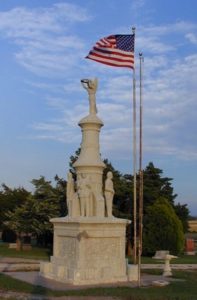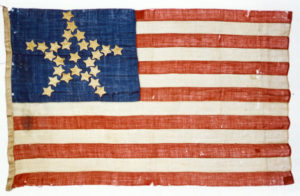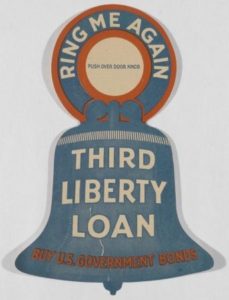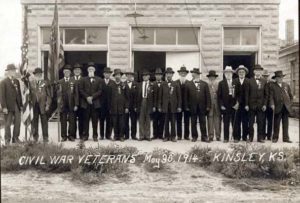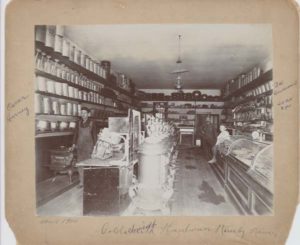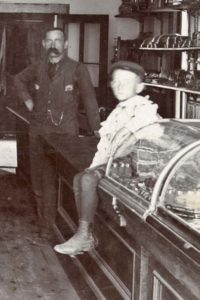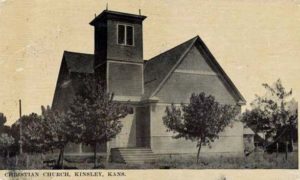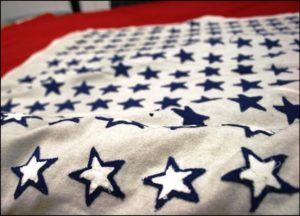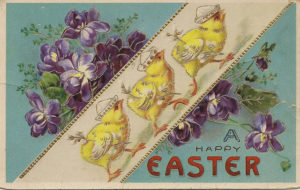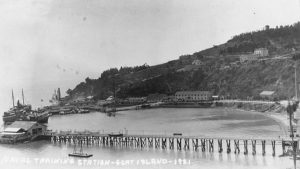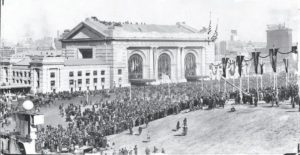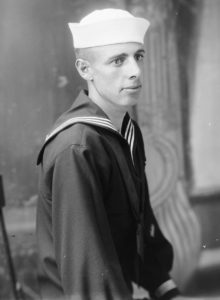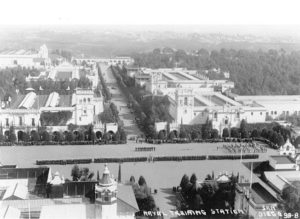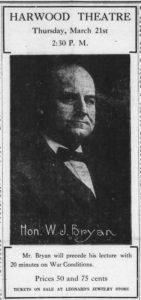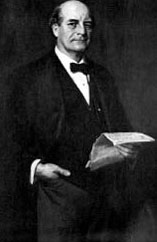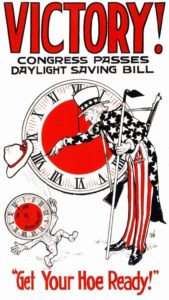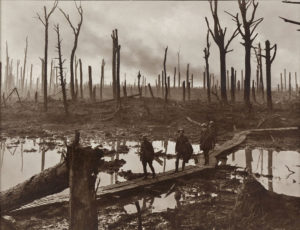Another article from the April 11, 1918 Kinsley Graphic caught my attention as it tells about a flag that was carried in the Loyalty Day parade mentioned in my last blog. This is another case of wondering what ever happened to that flag?” Hopefully it found its way to a museum. The article in the Kinsley Graphic begins:
“One of the interesting features of the patriotic demonstration Saturday was the appearance in the parade of the company flag of Co. C, 27th New York Infantry. This flag is now in possession of Mr. Floyd Wellman, of this city. David Lester, an old soldier, resident here for many years, was in Company F of the 27th New York Infantry and was personally well acquainted with its history.”
Mr. Wellman was a well-respected, long-time citizen of Kinsley. He was born September 8, 1854 in Steuben County, New York. He moved with his parents to a farm southwest of Kinsley in 1886. When his father’s died in 1891, he and his mother moved into Kinsley where he was elected township trustee, a position he held for many years. He worked caring for the roads.
David Lester was active in the G.A.R. (Grand Army of the Republic) and was probably riding in one of those automobiles at the front of the parade. Perhaps the flag was flown or carried by a G.A.R. member or Mr. Wellman. Lester is best-known as the creator of the Civil War Monument in Hillside Cemetery outside of Kinsley. He was 74 years old when he made the monument out of cement in 1917. It is on both the Kansas and National Historic Registries.
But back to the story about the flag in the Graphic.
“The old flag is in fairly good preservation still and is carefully treasured by Mr. Wellman and only brought out on important occasions. There is no record of the flag prior to its coming into possession of Co. C. It carries 26 stars. This would indicate that it was made after the admission of Michigan to statehood in 1837 and prior to the admission of Texas in 1845.”
The flag may have looked like this one below, but there is no way of knowing for sure.
The article goes on to tell the known history of the flag.
“The 27th assembled at Elmira and as mess halls were scarce, school houses, churches and the larger residences were used. F. W. Morrow, uncle of Mr. Wellman, had a large house and moved his family to the upper story and Co. C, had the use of the lower floor for a mess hall. Floyd Wellman was a little chap of seven years and the company took a great liking to him and kept him with them most of the time while in the city. The regiment was mustered into the service of the United States July 5th, 1861 and dated May 21. They fought in thirteen major engagements and many small battles, and returned to Elmira and were mustered out June, 1863. The remnant of Co. C, again visited the Morrow family and renewed their friendship with Floyd. Most of them re-enlisted and as they were to be scattered, they decided to leave their old company flag with Mrs. Morrow until such time as they could reclaim it. It remained in her possession for a number of years and was not called for. Finally she sent it to her nephew, Floyd Wellman, of this city, who cherishes it as one of his most prized possessions.”
Although the following tidbit is quite far afield from WWI or the parade, I can’t help including it on this blog. An article in the Kinsley Graphic (November 30, 1922) told how Floyd Wellman loaned his mother’s scrapbook of Civil War era articles to the editor who found a picture of Abraham Lincoln in it, and wrote the following:
“Floyd related a story of the greatest fight it was ever his pleasure to witness between two women. A few days after the assassination of Lincoln a Union soldier who had lost an arm in the war was on the streets of Elmira, New York, selling pictures of Lincoln. Stepping up to a woman, the soldier requested her to buy a portrait, to which the customer replied, she would not have it in the house, but if he had a picture of Booth, the assassin, she would buy enough of them to cover the walls of her home. The soldier told another lady concerning the remark made by the first woman. Accosting the offender, the second lady, hit the one who made the remark, between the eyes with all her might, and a real fight, stripped of the propriety of Marquis of Queensbury rules ensued. Floyd was eleven years old at the time, and remembers the incident as though it were but yesterday. He bought one of the pictures.”
Again, I ask help wondering whatever happened to that picture and scrapbook?”

